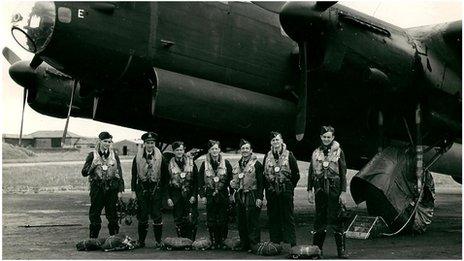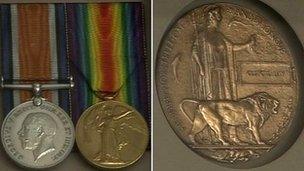Waterbeach Barracks museum contents saved by villagers
- Published

Lancaster bombers were based at RAF Waterbeach. This crew was photographed there in 1945
The contents of a military museum, which closed in September, have been saved by residents determined that the history of their Cambridgeshire village should not be lost.
The museum was housed at Waterbeach Barracks, north of Cambridge. The entire site is set to close in early 2013 as part of Ministry of Defence (MoD) cuts.
Artefacts gathered since the station was opened in 1941, including photographs and medals, were set to be dispersed before villagers got together to ensure that would not happen.

Medals awarded to three Waterbeach brothers are part of the museum's collection
They set up a trust and the museum's contents have been officially signed over to them.
Oliver Merrington, the museum's curator, said he was extremely pleased "to have found such an excellent group of trustees" which includes retired army staff.
About 900 personnel and relatives from 39 Engineer Regiment have moved off the base and been deployed to the former RAF base at Kinloss.
The barracks site is currently being considered for development by South Cambridgeshire District Council.
Adrian Wright, chair of the Waterbeach Military Heritage Museum, said: "The museum is part of the heritage of the village and the heritage of so many squadrons that were stationed there.
"It's so good that we've had this opportunity to save this museum for the future."
Brothers' medals
The items will be stored in the village while a new venue is sought.
They include the medals awarded to Walter, Jack and Clifford Day who were born in Waterbeach and died in World War I.
The former curator, retired major David Hornby, said: "Little was known about the brothers until a local man found the medals at a Norwich auction a few years ago.
"He purchased them for the village and they were given to the museum."
The museum was set up by the Royal Engineers in 1985, to commemorate the men and women who served at RAF Waterbeach station from its opening until 1966 when 39 Engineer Regiment moved there.
It also tells the story of the regiment since its arrival in Cambridgeshire.
Scattered ashes
Much of the material in the museum was donated by members of 514 Squadron who flew Lancasters from the station during World War II.
Veterans from the squadron return to the village every summer for a reunion, and hope to continue this tradition.
Maj Hornby said: "They come from all over the world and they want to keep returning to the museum."

Artefacts gathered since the station opened in 1940 are housed in the museum
He said the barracks site also contained a memorial garden where the ashes of 13 squadron members had been scattered.
Bernard Yeomans, 91, who was a Leading Aircraftsman at RAF Waterbeach from 1942, has attended the reunions for more than 15 years.
"A lot of the photographs in the collection are of people I recognise," he said.
"I don't think people realise the casualty rate among Bomber Command.
"The first 1000-bomber raid by 514 Squadron was from Waterbeach - the last one was a disaster because we sent eight aircraft and we only got four back."
'Heritage site'
Mr Merrington will spend next year cataloguing the collection and creating a photographic record of each item.
He hopes the museum will reopen on the airfield when it is developed.
"We have had an assurance from the most likely developers of the MOD-owned airfield and barracks that the inclusion of a museum will form an important part of the site's heritage," he said.
Maj Hornby added: "This is 72 years of the history of Waterbeach and it's important that we retain that history forever."
- Published11 August 2012
- Published9 January 2012
- Published19 July 2011